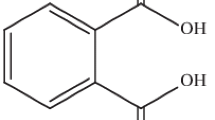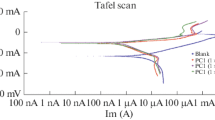Abstract
The inhibition of copper corrosion in aqueous media by inorganic phosphates has been studied using a chemiometric approach (experimental and simplex designs). To achieve the objective, four steps were recognized. When submitted to aqueous aggressive media, the anion nature and its concentration were the important variables for the explanation of the mass loss variation. The most corrosive experimental conditions were: anion: chloride (Cl−); concentration: [Cl−] = 1 mol/l; exposure time: 24 h. In the second step, two inorganic phosphates, Na3PO4 and Na5P3O10, are tested as copper corrosion inhibitors when the material is submitted to the severe conditions. The chemical structure was found to be the most influent factor. However, %IE varies between 25% and 56%. Then, we recognized a passivating treatment by submitting copper to inhibitor solution before immersion in the aggressive medium. Three parameters were studied: inhibitor structure, chemical concentration and passivation time (tp). We concluded that tp is the most influent experimental factor. The best passivating conditions are: inhibitor: Na5P3O10; inhibitor concentration: [Inhibiteur] = 10−2 mol/l and passivation time: 3 h. The inhibition efficiency was 89%. To increase %IE, a simplex design was also performed starting by the above obtained conditions and using the polyphosphate (Na5P3O10) as inhibitor. The optimum experimental conditions for phosphate inhibition of copper corrosion in aqueous media are: inhibitor: Na5P3O10, [Na5P3O10] = 0.017 mol/l and passivation time tp = 2.17 h. Under these conditions an inhibition efficiency of 98% was reached.



Similar content being viewed by others
References
Ateya BG, Ashour EA, Sayed SM (1994) J Electrochem Soc 141(1):71
Feng Y, Siow K-S, Teo W-K, Tan K-L, Hsieh A-K (1997) Corrosion 53:389
Debiemme-Chouvy C, Ammeloot F, Sutter EMM (2001) Appl Surf Sci 174:55
Bjorndhal WD, Nobe K (1984) Corrosion 40:82
Dhar HP, White RE, Burnell G, Corwell LR, Griffin RB, Darby R (1985) Corrosion 41:317
Delouis C, Mengoli G, Musiani MM, Tribollet B (1988) J Appl Electrochem 18:374
Feng Y, Teo W-K, Siow K-S, Tan K-L, Hsieh A-K (1996) Corros Sci 38:369
Proctor and Gamble Ltd. British Patent no. 652339, 1947
Cicelio GP, Rosales BM, Varela FE, Vilche JR (1999) Corros Sci 44:1359
Guenbour A, Kacemi A, Benbachir A (2000) Prog Org Coat 39:151
Trachli B, Keddam M, Takenouti H, Srhiri A (2002) Corros Sci 44:997
Kerit S, Aride A, Srhiri A, Benbachir A, Elkacemi K, Etman M (1993) J Appl Electrochem 23:835
Taneichi D, Haneda R, Aramaki K (2001) Corros Sci 43:1589
Haneda R, Aramaki K (1998) J Electrochem Soc 145:2786
Perrin FX, Pagetti J (1998) Corros Sci 40:1647
Fenelon AM, Breslin CB (2002) Electrochim Acta 47:4467
Kalman E, Karman FH, Cserny I, Telegdi J, Varga D (1994) Electrochim Acta 39:1179
Gonzalez Y, Lafont MC, Pebere N, Chatainier G, Roy J, Bouissou T (1995) Corros Sci 37:1823
To XH, Pebere N, Dabosi F, Pelaprat N, Boutevin B, Parisi JP, Galvano-Organo-Traitement de surface, (654) 760 (1995) et dans le Procceding du 9ème Forum des impédances électrochimiques, Ed. C. Gabrielli, Paris (1995) 115
To XH, Pebere N, Pelaprat N, Boutevin B, Hervaud Y (1997) Corros Sci 39:1925
Truc TA, Pebere N, Hang TTX, Hervaud Y, Boutevin B (2002) Corros Sci 44:2055
Muller B, Foster I (1996) Corros Sci 38:1103
Edwards M, Hidmi L, Gladwell D (2002) Corros Sci 44:1057
Souissi N, Bousslemi L, Khosrof S, Triki E (2003) Mater Corros 54(4):318
Standard procedure ASTM G1-90 (reapproved 1999)
Kiefer J, Wolfowitz J (1960) Can J Mathemat 12:363
Box GEP, Hunter JS, Hunter W (1978) Statistic for experimenters: an introduction to design, data analysis and model building. Wiley, New York
Goupy JL (1993) Methods for experimental design. Elsevier, Amsterdam
Haaland PD (1989) Experimental design in biotechnology. Marcel Dekker, New York and Basel
Spendley W, Hext GR, Himsworth FR (1962) Technometries 4:441
Author information
Authors and Affiliations
Corresponding author
Rights and permissions
About this article
Cite this article
Souissi, N., Triki, E. A chemiometric approach for phosphate inhibition of copper corrosion in aqueous media. J Mater Sci 42, 3259–3265 (2007). https://doi.org/10.1007/s10853-006-0809-x
Received:
Accepted:
Published:
Issue Date:
DOI: https://doi.org/10.1007/s10853-006-0809-x




